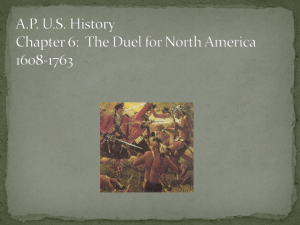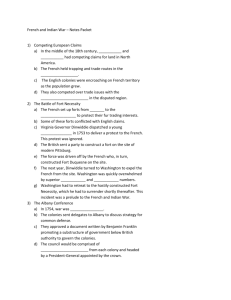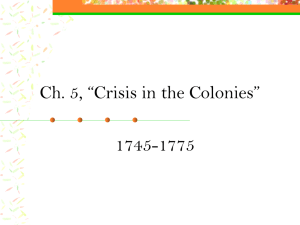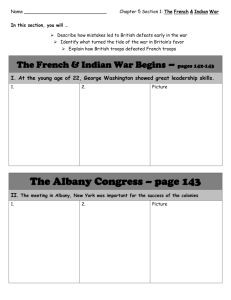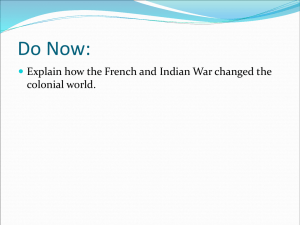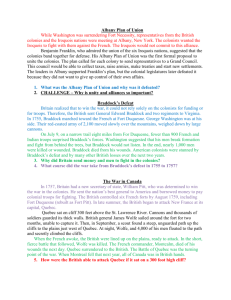French/Indian War Reading
advertisement
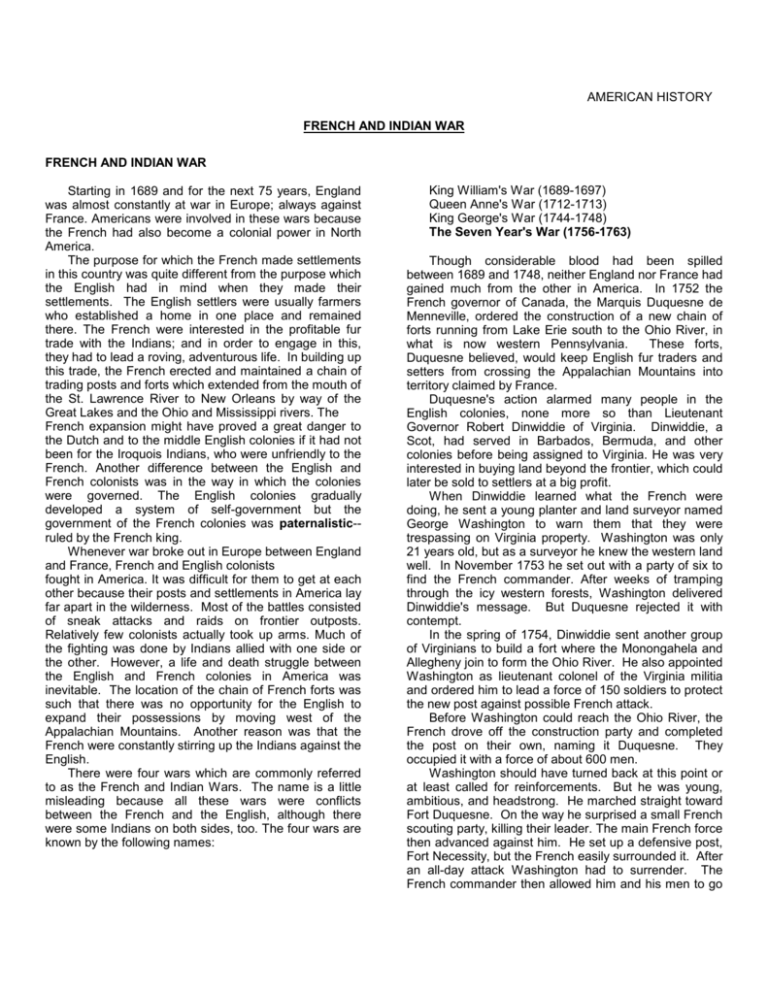
AMERICAN HISTORY FRENCH AND INDIAN WAR FRENCH AND INDIAN WAR Starting in 1689 and for the next 75 years, England was almost constantly at war in Europe; always against France. Americans were involved in these wars because the French had also become a colonial power in North America. The purpose for which the French made settlements in this country was quite different from the purpose which the English had in mind when they made their settlements. The English settlers were usually farmers who established a home in one place and remained there. The French were interested in the profitable fur trade with the Indians; and in order to engage in this, they had to lead a roving, adventurous life. In building up this trade, the French erected and maintained a chain of trading posts and forts which extended from the mouth of the St. Lawrence River to New Orleans by way of the Great Lakes and the Ohio and Mississippi rivers. The French expansion might have proved a great danger to the Dutch and to the middle English colonies if it had not been for the Iroquois Indians, who were unfriendly to the French. Another difference between the English and French colonists was in the way in which the colonies were governed. The English colonies gradually developed a system of self-government but the government of the French colonies was paternalistic-ruled by the French king. Whenever war broke out in Europe between England and France, French and English colonists fought in America. It was difficult for them to get at each other because their posts and settlements in America lay far apart in the wilderness. Most of the battles consisted of sneak attacks and raids on frontier outposts. Relatively few colonists actually took up arms. Much of the fighting was done by Indians allied with one side or the other. However, a life and death struggle between the English and French colonies in America was inevitable. The location of the chain of French forts was such that there was no opportunity for the English to expand their possessions by moving west of the Appalachian Mountains. Another reason was that the French were constantly stirring up the Indians against the English. There were four wars which are commonly referred to as the French and Indian Wars. The name is a little misleading because all these wars were conflicts between the French and the English, although there were some Indians on both sides, too. The four wars are known by the following names: King William's War (1689-1697) Queen Anne's War (1712-1713) King George's War (1744-1748) The Seven Year's War (1756-1763) Though considerable blood had been spilled between 1689 and 1748, neither England nor France had gained much from the other in America. In 1752 the French governor of Canada, the Marquis Duquesne de Menneville, ordered the construction of a new chain of forts running from Lake Erie south to the Ohio River, in what is now western Pennsylvania. These forts, Duquesne believed, would keep English fur traders and setters from crossing the Appalachian Mountains into territory claimed by France. Duquesne's action alarmed many people in the English colonies, none more so than Lieutenant Governor Robert Dinwiddie of Virginia. Dinwiddie, a Scot, had served in Barbados, Bermuda, and other colonies before being assigned to Virginia. He was very interested in buying land beyond the frontier, which could later be sold to settlers at a big profit. When Dinwiddie learned what the French were doing, he sent a young planter and land surveyor named George Washington to warn them that they were trespassing on Virginia property. Washington was only 21 years old, but as a surveyor he knew the western land well. In November 1753 he set out with a party of six to find the French commander. After weeks of tramping through the icy western forests, Washington delivered Dinwiddie's message. But Duquesne rejected it with contempt. In the spring of 1754, Dinwiddie sent another group of Virginians to build a fort where the Monongahela and Allegheny join to form the Ohio River. He also appointed Washington as lieutenant colonel of the Virginia militia and ordered him to lead a force of 150 soldiers to protect the new post against possible French attack. Before Washington could reach the Ohio River, the French drove off the construction party and completed the post on their own, naming it Duquesne. They occupied it with a force of about 600 men. Washington should have turned back at this point or at least called for reinforcements. But he was young, ambitious, and headstrong. He marched straight toward Fort Duquesne. On the way he surprised a small French scouting party, killing their leader. The main French force then advanced against him. He set up a defensive post, Fort Necessity, but the French easily surrounded it. After an all-day attack Washington had to surrender. The French commander then allowed him and his men to go free. They returned to Virginia, leaving the disputed territory to the French. With Washington's retreat the war began in earnest. In all North America there were no more than 90,000 French settlers. The population of the English colonies was about 1.5 million. Thousands of British soldiers took part in the struggle. Yet for about two years the outnumbered French won all the battles. They were experts at forest (guerrilla) warfare. Most of the Indians sided with them, for unlike the English, the French colonists were mostly interested in the fur trade. They did not try to force the Indians to give up their lands or abandon their ways of life. In 1754 the British government asked for a colonial conference to make a firm treaty of alliance with the powerful Iroquois Indian nation. Representatives from New York, Pennsylvania, New Hampshire, Massachusetts, Connecticut and Rhode Island attended the conference in Albany, New York. The Iroquois had long maintained a seldom broken peace with the English. Now, however, they had complaints over land and trade agreements that were being violated. It was vital to the British government that the Iroquois remain their allies. If the Iroquois joined the French, it would be disastrous for the British. After discussing relations with the Iroquois, the Albany Congress took up the questions of general colonial defense. Benjamin Franklin of Pennsylvania and Thomas Hutchinson of Massachusetts presented a plan of union for the colonies. "The Albany Plan of Union" called for a "Grand Council" which would have the power to maintain an army, deal with Indian problems, regulate expansion westward, and levy taxes. This plan did not gain support either among the colonies or in Parliament. Even in time of war, each colony had tended to act alone. Jealous of its independence, each colony pursued whatever course its leaders and people thought would be in their own best interest. The British government was not enthusiastic about Franklin's plan or any other sort of colonial union. If the colonies united on any basis, they threatened British control of them. The first political cartoon in America by Benjamin Franklin: Early in 1755 Major General Edward Braddock arrived in Virginia with two regiments of red-coated British soldiers. His orders were to drive the French out of Fort Duquesne. Braddock was a veteran with over 40 years in the British army. But his long military experience proved a disadvantage in America. Instead of moving swiftly along forest trails, guided by Indian scouts, he carved a road through the wilderness so that he could haul heavy cannon for the attack on the French. Under such conditions surprise was impossible. As the troops approached Fort Duquesne, the French were ready for them. When Braddock's force of 1,400 men was passing through a narrow gulch about 8 miles from the fort, the woods suddenly exploded with gunfire. Redcoats fell by the hundreds. Panic spread among the survivors. Braddock fought bravely but finally went down, a bullet through his lungs. In the long run, however Braddock's campaign might be considered a success because his road became the means by which English settlers moved into and conquered the entire Ohio Valley. Colonel Washington, who was serving under Braddock, miraculously escaped injury. A big man, well over six feet, he must have presented a tempting target as he tried to rally and organize the British soldiers. Two horses were shot from under him. After he had finally led the 500 survivors back to safety, he discovered four bullet holes in his coat. The British were not easily discouraged. The tide began to turn after a brilliant English politician, William Pitt, was elected Prime Minister of England and took over management of the war effort. He sent over more troops and supplies. In 1758 English troops finally captured Fort Duquesne. They changed its name to Fort Pitt, which is why the modern city on the site is named Pittsburgh. Gradually other key French posts were taken. The most decisive battle occurred at the city of Quebec in 1759. Quebec is located on a cliff overlooking the St. Lawrence River. The British attack force, led by General James Wolfe, could not at first find a way to get up the cliff without being exposed to murderous fire. Then one day Wolfe noticed some women washing clothes on the bank of the St. Lawrence. The next day he saw the same clothes hung out to dry on the cliff above. There must be a hidden path up the cliff! Wolfe investigated, found the path, and in the dead of night moved his army up to the city. There on a field called the Plains of Abraham, the battle took place. Both Wolfe and the French commander, General Louis Joseph de Montcalm were killed. This fight ended with the surrender of Quebec to the English. By this time the conflict had spread through the world, including Europe, where it had been called the Seven Years' War. Everywhere the British were victorious. French outposts in Asia and Africa were captured. Spain entered the conflict on the side of France in 1761, only to see its colonies in Cuba and the Philippine Islands overwhelmed by the British. When the war ended in 1763, the British were able to redraw the map of the world. Outside of North America they were remarkably generous. The Treaty of Paris of 1763 stated that the British would return most of the lands they had conquered. France gave up all the territory east of the Mississippi River except New Orleans. France also ceded Canada and the region south of the Great Lakes. Spain, who had allied with France, gave Florida to Britain. France gave Spain New Orleans and all the land west of the Mississippi. Nearly everyone in the English colonies in America was delighted with the outcome of the war. The French threat had been removed. Spain had been pushed back from the southern frontier. The way to the West lay open. Although some of the colonies had contributed men and money to the conflict, British soldiers and sailors had done most of the fighting. The royal treasury paid most of the bills. Never did Americans feel more loyal to the king or more grateful to England than in 1763. QUESTIONS Answer these in your Cornell notes notebook. Title the page “French and Indian War Reflection Questions” 1. ANALYZE Franklin’s “Join or Die” cartoon. Explain the message Franklin was trying to send to his fellow colonists? Explain how British officials may have viewed/interpreted this cartoon? 2. EXPLAIN how the French were able to win the majority of the battles during the first 2 years of the war even though the British had more soldiers? 3. Identify the group in North America that would not have been “delighted” that the British colonists had access to the lands in the west. 4. Explain the economic benefit that the winner of the French and Indian War received and how this caused France and England to commit so much of their financial and military resources to fighting in North America.

